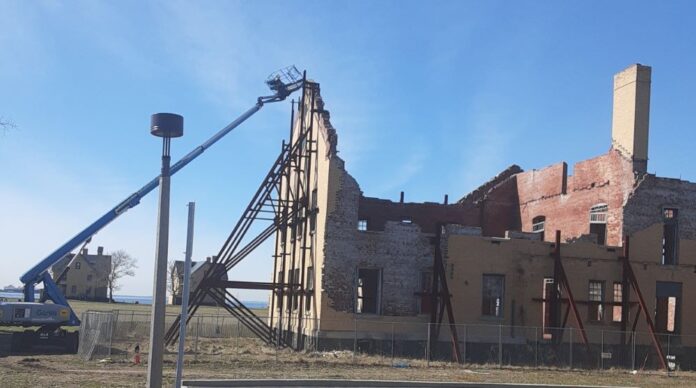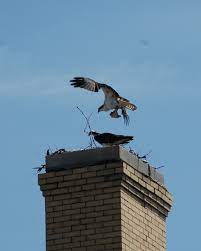Osprey Nest Removed
As all those avidly hoping for the reconstruction of Building 23 on Fort Hancock have seen, the osprey nest which has rested at the top of the lone standing wall of the dilapidated former army barracks for years, halting all progress and causing much controversy for years, is gone.
The nest, which for years has stalled progress on the anticipated indoor training facility for students at MAST, the Marine Academy of Science and Technology, was suddenly absent last Wednesday, according to visitors to Sandy Hook. The empty nest had been at the top of the last standing wall of the dilapidated building more than a week ago. The day after it disappeared, a bright blue boom appeared on the side of the wall and has been there since.
Kelly Brazelton, business manager for the Monmouth County Vocational School district, confirmed the nest was removed at the direction of the school district. And the boom, also placed by the district, was put in place last Thursday and will remain there for a month or so.
MS Brazelton did not give any explanation for why the boom is on site or how the nest was removed.
The nest has been a critical part of the years long story of reconstruction of the former barracks into a training facility, classrooms and offices, together with bathrooms and showers for cadets at MAST, the Marine Academy of Science and Technology, all of whom are in the NJROTC program.
When plans were first begun for the building several years ago, construction was planned to begin in the spring of the year. However, the nest, which has been there for years, was inhabited by returning ospreys, whose nature it is to return to the previous year’s nest after each migration, building it larger each season. Environmental regulations ban the removal or disturbance of osprey nests so long as they are an active family, from eggs to flight, so plans were put on hold for reconstruction. Following the nesting season, no action was taken by the district to remove the nest. Birds normally return by mid-March to their former site.
Last December, while the nest was still intact, the school district called for bids for construction, setting $15 million as the top cost allocated for construction. No action was taken to remove the nest throughout the winter months.
The bids were opened in January when two bids for construction of the new facility were received. Both were rejected when they came in at over $18 million.
While the district is expected to modify its plans and submit new and presumably less expensive construction plans to continue its agreement with the National Park Service, Ms. Brazelton reported there is nothing new on the construction plans at this time.
This month, the nest is gone and a boom at unknown cost is on site with no explanation of its purpose.
Booms are a piece of construction equipment that enables workers to climb and assess or inspect sites at the higher level. But when asked the purpose for the equipment remaining on site for a month or more, or its cost, Ms Brazelton responded “I am unable to answer some of your questions.”
Nor did VeniVidiScripto get any response from National Park Service superintendent for Gateway National Recreation Area Jen Nersessian in responses to the same questions.





